
A Visit with the Dowager of Chatsworth
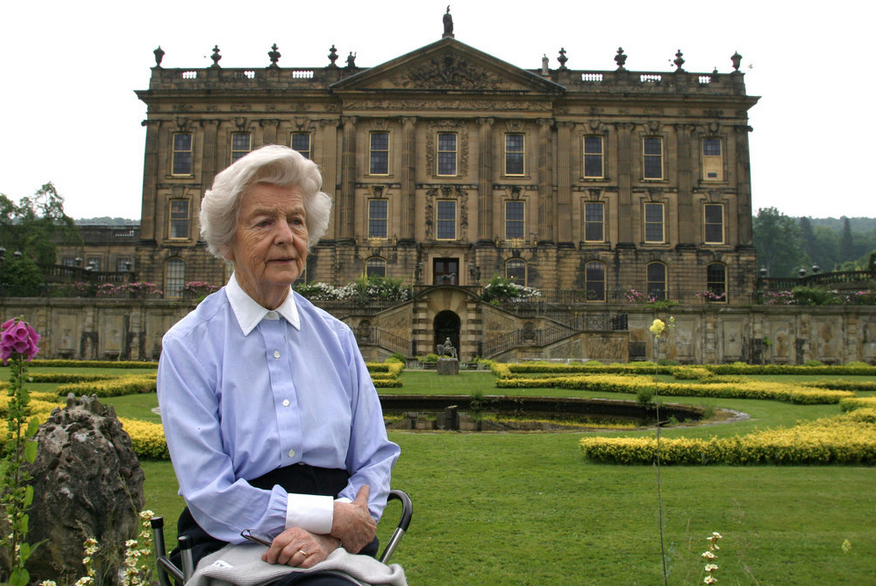
Deborah, Duchess of Devonshire (above), chatelaine saviour of Chatsworth and the last of the Mitford Sisters, would have been 100 today. The sixth daughter and seventh and last child, she was the Lord and Lady Redesdales’ final chance for a second son. Mabel their parlourmaid recalled, “I knew it was a girl by the look on his lordship’s face.” Nine decades later, this disappointing arrival wrote in her memoirs, “Blank. There is no entry in my mother’s engagement book for 31 March 1920, the day I was born. The next few days are also blank. The first entry in April, in large letters, is ‘KITCHEN CHIMNEY SWEPT’. Who could have imagined the life that lay ahead? In any case, this milestone, a century later, recalled this writer’s visit to the Palace of the Peak in October 2005 to satisfy a lifelong ambition — to meet one of the Mitfords.
One of the ducal cars (but not, alas ,the old duke’s Bentley with the Devonshire crest) brought me from the station, through the private entrance where Henry, the Irish butler, greeted me. There, at the end of a narrow, winding staircase in the private quarters, is Debo, or to give her her due, Her Grace the Dowager Duchess of Devonshire, sitting in her chair appropriately enough in the Duchess’s Sitting Room amid 46 years of accumulated treasures and clutter. At 85, the beauty and brio of her youth still lingered. The famously blue eyes of the Mitfords occasionally gazed out of the huge window as weekend visitors poured into the House below.
It cannot have been good for anyone to be addressed as ‘Your Grace’ for sixty years. But since 1950, when her husband, Andrew Cavendish, became the 11th Duke of Devonshire on the sudden 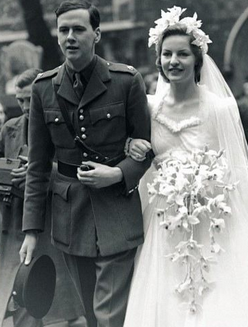 death of his father, Deborah Vivien Freeman Mitford (‘Debo’ to her family and friends) was so addressed by the hundreds of people who lived and worked on the family estate. She appeared to accept it with equanimity and (well) good grace.
death of his father, Deborah Vivien Freeman Mitford (‘Debo’ to her family and friends) was so addressed by the hundreds of people who lived and worked on the family estate. She appeared to accept it with equanimity and (well) good grace.
But when she fell in love with Andrew Cavendish (right) and they wed at 21, he was the second son and not expected to inherit the dukedom. It was only when his elder brother, William, Marquess of Hartington was killed in 1944 and it became clear that William’s widow, Kathleen ‘Kick’ Kennedy, JFK’s sister, was not expecting a child, that Andrew became heir to his father and, in 1950, duke and the master of Chatsworth.
The seat of the Cavendishes since 1549, for sixteen generations, Chatsworth (‘the House’) lies in a valley in the Peak District in the middle of England. Approaching from the station, ‘The Palace on the Peak’ almost beggars description. It is, as one writer noted, as if an enormous town hall had been landed in a valley dotted with deer and grazing sheep. This splendid caramel-coloured pile, rebuilt at the end of the 17th century, has 175 rooms, 397 external windows, 21 kitchens and 17 staircases – all under a roof covering more than an acre.
It is almost impossible to separate the real Mitford sisters from their fictional equivalents. Nancy’s amusing confections, The Pursuit of Love and Love in a Cold Climate made cult figures of her already notorious family and it seems that even Jessica’s memoir Hons and Rebels was coloured more by these novels than her actual experience. The early lives of the sisters seem as remote today as those of the Brontës. In fact, David Mitford, 2nd Lord Redesdale – ‘Farve’ to his children — echoed the words of Mr Bennet when he once roared in despair: “I’m normal, my wife is normal, but my daughters are each more foolish than the other.” For her part, Lady Redesdale, ‘Muv’ to her children, was often exasperated by their antics. “Whenever I see a headline beginning with ‘Peer’s Daughter’ I know one of you children has been in trouble.’’
Despite his remark, ‘Farve’ was not (then at least) anyone’s idea of a regular aristocrat. Immortalised by Nancy and Jessica, he was a philistine backwoods peer given to building houses and erupting in blinding rages. As their finances dissolved and the family moved, the girls would chant “from mansion, to manor, to house, to cottage.” Family folklore claimed Farve had only ever read one book, White Fang, and found it so good he felt no need to read another, yet he kept much of his father’s impressive library and his letters to his children tend to be tender and amusing. He did not believe in school for “gels” (their one brother, Tom, was sent to Eton) so they remained “cut orf” at home, where “Muv” had them reading The Times leader by the age of six.
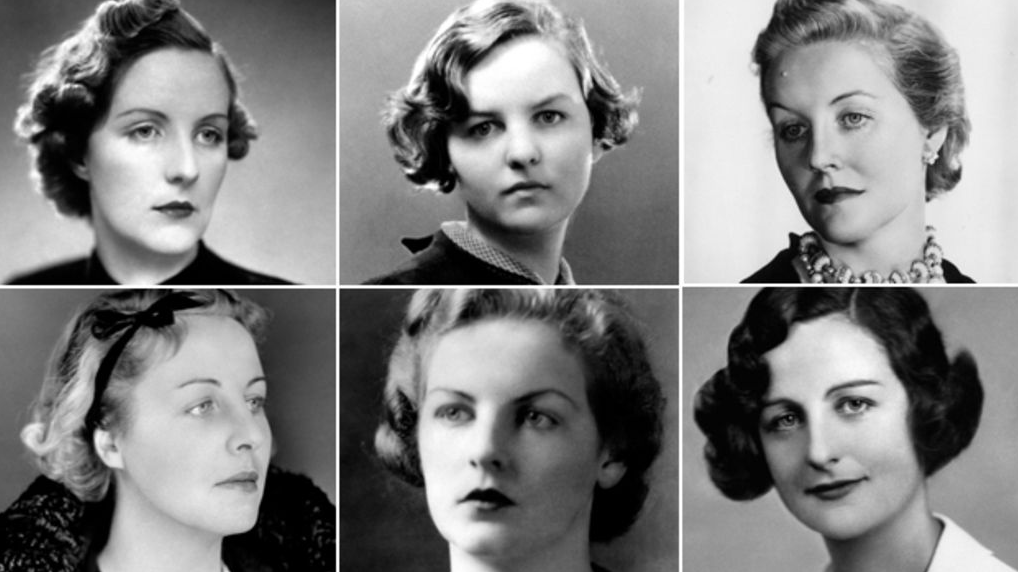
The Mitford gels (clockwise from top left): Unity, Jessica, Diana, Nancy, Deborah, Pamela
While Nanny remained a constant, a succession of 15 governesses were frightened off by endless intricate jokes, “shrieks” (of laughter), “floods” (of tears) and 35 nicknames ricocheting around the house.
All the girls were brilliantly blue-eyed, except green-eyed Nancy who resented not being an only child and teased her sisters relentlessly. Nancy told the youngest three, Unity, Jessica and Deborah that the middle of their names made them ‘nic’, ‘sic’ and ‘bor’. All of them, but Debo, itched to be free of this hothouse isolation, and by the outbreak of war the family had dispersed.
By 1939, Nancy already had written a few precursors to her best-selling novels, and after a broken engagement she wed a good-looking old Etonian and fellow Hon, Peter Rodd. He was undoubtedly clever but marriage to Nancy proved a mistake and “Prod” was cast as feckless, idle and worst of all, in Mitford eyes, a bore.
Pamela became a farmer and married (the second of his six wives) Derek Jackson, a brilliant bisexual physicist and a son of the owner of News of the World. John Betjeman, who had loved her, described her as ‘the most rural of them all’. ‘Farve’ introduced her at a lunch one day “This is my daughter Pamela, the best judge of a pig’s face in the south of England.” Diana divorced her pleasant Guinness husband and secretly wed Oswald Mosley, leader of the British Union of Fascists. Unity, after months of stalking Hitler in Munich, had become part of his circle. And Jessica, as she had long threatened, had eloped with her cousin, Esmond Romilly. Debo was still at home.
Their bewildered parents had become estranged as “Muv” came to admire the Nazis and “Farve” reverted to hating “the Hun”. Nancy was not “on speakers” with Diana and Unity for sending up Mosley in her novel Wigs on the Green. Some of these rows lasted till death.; Diana and Decca 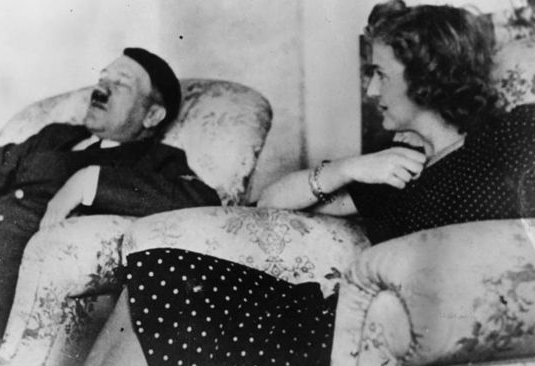 were never to reconcile. The only one “on speakers” with everyone was Tom who claimed to be “red” when with one sister and gave the fascist salute when with another. Debo was considered too young to be permitted a view.
were never to reconcile. The only one “on speakers” with everyone was Tom who claimed to be “red” when with one sister and gave the fascist salute when with another. Debo was considered too young to be permitted a view.
Unity’s diary records 140 meetings with Hitler (as at left) in four years, which, given that he had a Reich to run, reveals a relationship of some significance. They called each other “Wolf” and “Kind” (Child) (“Oh he’s sweet in his dear little old mackintosh’’). Although she would have jumped at the chance, it is unlikely she ever curled up with the Fuehrer.
Meanwhile, Diana also was spending time in Germany and with Hitler, attempting to obtain a radio licence to transmit light music (lieder??) into Britain and thereby fund Mosley’s cash-strapped Blackshirts. She admired but was not in love with Hitler; as biographer Jan Dalley quipped, “After all, Diana had her own Fuehrer at home.” Nancy had fallen irrevocably in love with Gaston Palewski (“the Colonel”), chef de cabinet for Charles de Gaulle, whom she also worshipped. “Muv” moaned, “Why do all my daughters fall for dictators?”
On a visit to Unity in Munich, Muv and Debo (who must be one of the last women alive to have met both Churchill and Hitler) were introduced to the Fuehrer. ‘’It was rather a wasted opportunity … because neither my mother nor I could speak German … he had rather a lovely bachelor flat’’, she recalled. Muv, to Unity’s mortification, lectured Germany’s Chancellor on the value of wholemeal bread. After she had met him over lunch, no nonsense Pam dismissed Hitler as “very ordinary; like an old farmer in a brown suit’’ but’ “Oh, the new potatoes…… they were absolutely delicious.’’ On hearing the declaration of war in Munich, Unity shot herself (but not quite fatally). The strain of her care at home proved too much for “Farve” who went to live on a Hebridean island he had bought.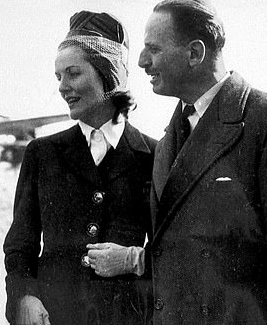
When Mosley was imprisoned in May 1940, Nancy went to the Home Office to say that Diana (the couple at right) was dangerous and should be locked up too. She spent three-and-a-half years in jail; on her release, Decca wrote furiously to Churchill demanding she be re-interned. The release provoked 20,000 protests, including a cable to the home secretary from the NSW Railway Union!
Debo and Andrew Cavendish had married two years earlier, both aged 21. Andrew was serving in the Coldstream Guards but, as he was a second son, they looked forward to a relatively leisurely life in the country. Debo wrote to Diana, ‘’I expect we will be terrifically poor but think how nice it will be to have as many dear dogs and things as one likes without anyone saying they must get off the furniture. I do wish you weren’t in prison…’’ His brother Billy Hartington’s death in 1944 changed it all, making Andrew the heir with the courtesy title Marquess of Hartington. Strangely, the same thing had happened to Farve, a second son, whose elder brother, Clement, was killed in 1916. For the rest of his life Andrew would say, “I’m Duke of Devonshire owing to a marksman killing my brother, so I’m here by proxy and I remind myself every morning when I wake up and again when I go to bed, that I am one of the luckiest men alive.” Then, in November 1950, when he was in Australia, his father, the 10th Duke, suddenly died. The timing of his father’s death was disastrous because of a critical tax deadline; the new duke, just 30, was taxed on 80 per cent of all his property, leaving the estate owing £7 million in death duties – a huge sum in 1950.
To survive, he sold Hardwick Hall, another ancient home, as well as 56,000 acres (22,600 hectares) in two counties, some books, tapestries, manuscripts, a Van Dyke, a Rubens, and a Holbein. He was chuffed that a Rembrandt turned out (much later) not to be a Rembrandt at all. His parents had moved out of Chatsworth in 1939. When they passed it, Debo would look up and say, “That’s a lovely house; I wonder who lives there?’’ In 1959 and more in awe, he said, of his wife than his accountant, he moved the family back into Chatsworth, and the Duchess set about making it a home, transforming it into a well-run estate and tourist attraction. They were to succeed brilliantly. Chatsworth was her life’s work and she proved to be arguably the greatest English chatelaine of her time.
It was at about this time, the duchess confirmed, that the Duke was offered the Governor-Generalship of Australia by Prime Minister Robert Menzies. This must have been just after the sudden death, in February 1961, in office, of the 14th Governor General, Viscount Dunrossil. Debo explained that the ages of their two elder children, Emma and Peregrine (“Stoker”), were such that they could not leave England. Viscount de L’Isle VC was appointed instead. And so, Canberra missed the chance to play host to the Devonshires and Yarralumla missed the shrieks, the roars and teases when the sisters would almost certainly have come to stay.
Perhaps because most of their adult lives were lived in exile – Nancy and Diana in France, Decca in America – they retained the exaggerated Edwardian tones of their childhood. Decca’s rendition, the year before her death, of Maxwell’s Silver Hammer sounds as if Queen Mary had been awarded a recording contract. (That remarkable performance can be heard above). Diana greeted visitors with “Oh! How wunn-derful! Are you exhors-ted? I hope you didn’t get looorst”. And there was Nancy, speaking endlessly on the phone during the war to a friend while on duty at Heywood Hill’s bookshop in Mayfair, being upbraided by a customer with, “A few less ‘darlings’ and a little more service please.’’ When Debo worked at a YMCA canteen in Eastbourne in 1944 everybody mimicked her accent. Like Nancy, who was told she could not lecture on fire-watching because her voice so annoyed audiences, they wanted to set her on the fire.
While still a treat for Australian ears, Debo’s accent was a little less languid, less exaggerated, but her pronunciation was still unmistakably Mitford. (Really good girls don’t take off and get lost; Rarely good gels don’t take orf and get lorst.) And the family’s genius for emphasis, begun by seven-year-old Tom, was kept alive by Debo. In the late 1990’s, at a lunch at Diana’s not far from Paris, Debo broke the ice with a guest “Did you come by train? You are clever!’’with the ‘are’ lasting a full three seconds. Our brief interview elicited a couple of ‘looorsts’ and one endless ‘’ “ex-troooooo-dn-ree’’
The 10th duke’s death duties debt took 17 years to clear. Andrew attributed their success to Debo (‘’She is quite bossy, but I like that in a woman’’). He commissioned, and they both befriended, a number of leading contemporary artists, Epstein, Elizabeth Fink, and Derek Hill. John Betjeman, Evelyn Waugh, Tom Stoppard, and Patrick (Paddy) Leigh Fermor were visitors and friends. Her sparkling correspondence with Paddy over half a century was published as In Tearing Haste in 2008. The duke spotted Lucian Freud’s talent in the ’50s. Most of the family were the subject of his portraits. Debo once overheard a visitor tell a friend as she passed Freud’s portrait of her in her early thirties, “That’s the dowager duchess; taken the year she died.’’
Royals had been guests at Chatsworth even before the days of the Prince Regent and the dazzling Georgiana, wife of the 5th Duke. In that tradition, Charles, Prince of Wales, was a constant visitor and confidant. And, by chance, on the day of my visit, Prince William was also at Chatsworth; gaining an insight into estate management. What better education in running an empire than spending time at Chatsworth? And so, the duchess’s royal links leapt into another generation. Royal biographer Graham Turner asserted some years ago that Prince Philip was in love with the young Debo. If so, who can gaze upon that face (below) and fail to understand.
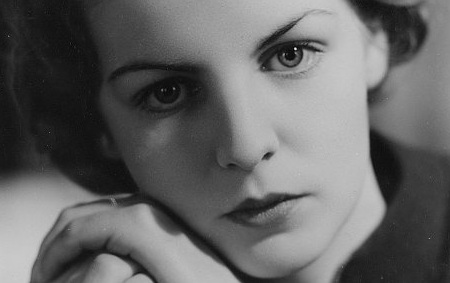
Theirs was a formidable partnership but they had their share of trials and tragedy. Three babies died at birth (named Mark, Victor and Mary and quietly baptised by their grandmother, the saintly “Moucher”, nee Mary Cecil, Duchess of Devonshire). Debo also suffered a number of miscarriages. The first coincided with the therapeutic termination of Nancy’s only pregnancy and a hysterectomy. (Muv rather unhelpfully observed “Ovaries – I thought one had 700, like caviar.’’) Three Cavendish children reached adulthood – Sophia joining Emma and ‘Stoker’ in 1957.
The duke was an interesting mix of strengths and flaws. While he was reputed to be one of the best mannered men in England (he was Patron in Chief of the Polite Society), he also loved to gamble and drink. And yet he had the strength to give them both up — gambling in the Sixties and drink in the mid-Eighties. He had a penchant for the gels but he was as ho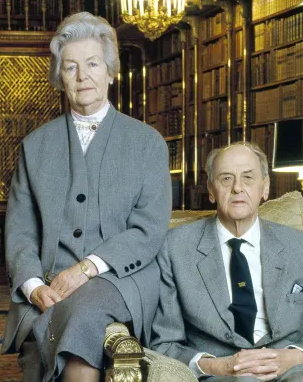 nest as he was modest. “Philandering is nothing to be proud of; it’s a weakness’’, he once observed. And yet the marriage prospered. Their old friend, the diarist James Lees-Milne, described them in the nineties as ‘like Darby and Joan’ (right). The duke credited his wife’s tolerance and the fact that they had no secrets.
nest as he was modest. “Philandering is nothing to be proud of; it’s a weakness’’, he once observed. And yet the marriage prospered. Their old friend, the diarist James Lees-Milne, described them in the nineties as ‘like Darby and Joan’ (right). The duke credited his wife’s tolerance and the fact that they had no secrets.
The duke died in May 2004 and his funeral was the occasion of an unforgettably feudal scene, as hundreds of uniformed estate workers lined the driveway as the duke’s coffin was borne from the House to the church. As has happened since 1707 when the first duke died, it was a case of ‘the duke is dead; long live the duke. Stoker became 12th duke; his wife, Amanda, the duchess, while Debo assumed the title Dowager Duchess of Devonshire. With typical English phlegm that would have made Farve proud, she carried on as before.
While the duke was a bibliophile (in fact he owned his own bookshop, Heywood Hill in Mayfair); Debo claims she did not read. Nancy used to call her “Nine”, citing it as her mental age. She also said that Debo needed to point to the words on the page to read. Evelyn Waugh (who knew she never read the books he gave her) joined in the tease and in her sitting room is a copy of his The Life of Ronald Knox inscribed “For Darling Debo, with love from Evelyn. You will not find a word in it to offend your Protestant sympathies.’’ Every page in the book is blank. That, and Beatrix Potter’s The Tale of Ginger and Pickles “the best book of retailing ever written’’), remain her favourites.
Well, this was a bit of a pose and she proved Nancy wrong by producing a dozen books. In 1982 she wrote Chatsworth: The House (1982); then in 1990, The Estate: A View from Chatsworth. The Treasures of Chatsworth and Farm Animals were published in 1991 and, in 1999, The Garden at Chatsworth. Two years later a best-selling collection of home thoughts and reviews, Counting My Chickens (2001) appeared. She had been a hen breeder for eight decades; in fact, the origin of ‘Hon’ began with ‘Hen’. In the Eighties when they met once again, Debo and Decca still called each other ‘Hen’. A further collection, Home to Roost and Other Peckings, followed in 2009; bundled into All in One Basket in 2011. In The Chatsworth Cookery Book (2003) she sought out Chatsworth’s capacious kitchen. It is not a place in which she has spent much time. In fact, she suggested the title: I haven’t cooked since the War, but her publisher advised against.
Next came Round About Chatsworth (2005) or, as she would have it, Rinde Abite Chatswth. The 35,000 acres that surround the House is plumb full of houses and architectural curiosities – bridges and byres, mills and a mortuary, turrets, towers and troughs, forests, fountains and follies. brimming with Devonshire knowledge and Mitford dash. Her Grace still had another book in her – Wait for Me, in 2010, her memoirs. Echoing the title, she followed her sisters, Diana, Jessica, and Nancy (most of whose fiction was autobiographical) in recording an astonishing life and surely the most reliable and rational account of what it was like to be a member of that fascinating brood.
As I left her sitting room after our brief encounter, I saw a poster of Elvis and remembered she was an ardent fan. A little over twenty years before she had seen a video of him performing in Las Vegas. She was bewitched. She couldn’t “bear music – unless it’s by Elvis … I’ve been to 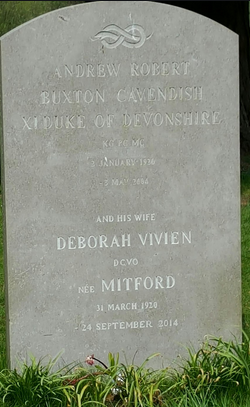 Gracelands – twice’’. What a pity she had not met him when he was still (officially) alive; he could have visited Chatsworth and got some tips for Gracelands (and, come to think of it, what a brilliant name for Chatsworth). Her favourite song by the King? ‘Ain’t it funny how time slips away’.
Gracelands – twice’’. What a pity she had not met him when he was still (officially) alive; he could have visited Chatsworth and got some tips for Gracelands (and, come to think of it, what a brilliant name for Chatsworth). Her favourite song by the King? ‘Ain’t it funny how time slips away’.
As I left the House and walked to the lodge to return to the station, she was standing at the window, looking out on a scene she had surveyed for nearly half a century. I like to think mine was the last or, at least, one of her last interviews. Two months after my visit, she left Chatsworth, 56 years after she had moved in, settling nearby into the old vicarage at Edensor, which she soon made her own. It was at Edensor that she began married life during the war. She continued to contribute to The Spectator as a columnist and reviewer; and promoted her memoirs with wit and brio. I loved her anecdote about a book-signing where an older man presented Debo with a copy of her book and asked her to inscribe “To Beryl, Sorry about last night”.
Not long after a triumphant book tour of the United States she lost her sight and, very quickly, her mind. The last few years were grim and her death on September 24, 2014, a blessing. The Prince of Wales led the mourners at her funeral, including 600 liveried staff who lined the route through the park to the church, St Peter’s Edensor. Among the traditional hymns and prayers, Elvis’s recording of ‘How Great Thou Art’ was played. A perfect adieu.
Madam: Archbishop Fisher (July-August 2024) does not resist the attacks on his church by the political, social or scientific atheists and those who insist on not being told what to do.
Aug 29 2024
6 mins
To claim Aborigines have the world's oldest continuous culture is to misunderstand the meaning of culture, which continuously changes over time and location. For a culture not to change over time would be a reproach and certainly not a cause for celebration, for it would indicate that there had been no capacity to adapt. Clearly this has not been the case
Aug 20 2024
23 mins
A friend and longtime supporter of Quadrant, Clive James sent us a poem in 2010, which we published in our December issue. Like the Taronga Park Aquarium he recalls in its 'mocked-up sandstone cave' it's not to be forgotten
Aug 16 2024
2 mins







